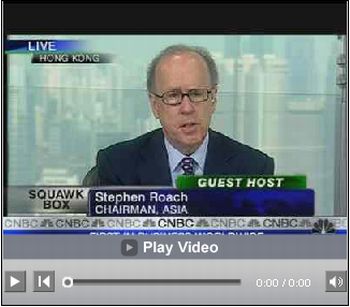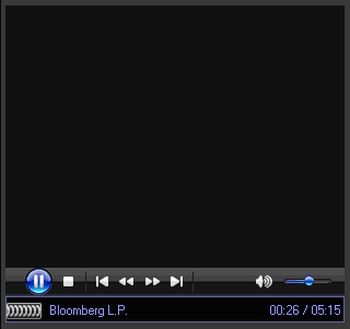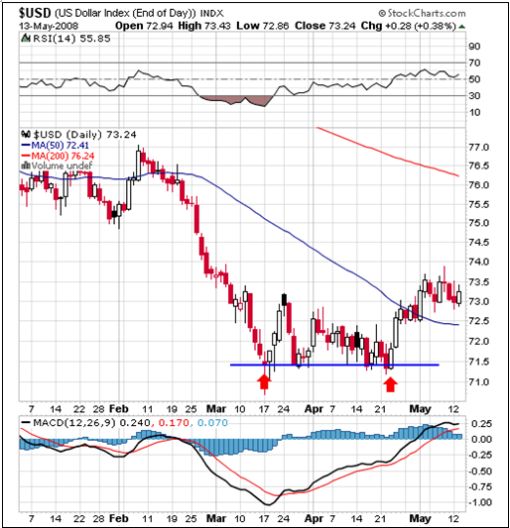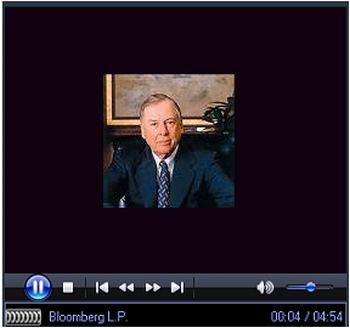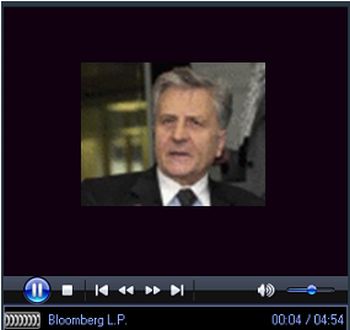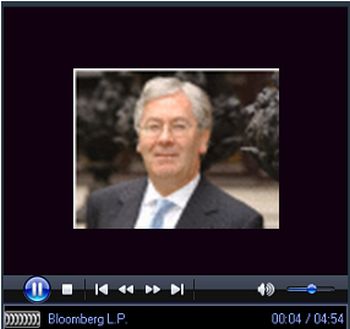Stock Market Euphoria May Prove Premature
Stock-Markets / Financial Markets May 20, 2008 - 12:11 AM GMT
 Equity bulls experienced another good week based on the viewpoint that the worst of the credit crisis might be behind us. A further improvement in investor sentiment and increased risk appetite caused market participants to cast aside a mixed bag of economic and corporate data and look across the “economic valley”.
Equity bulls experienced another good week based on the viewpoint that the worst of the credit crisis might be behind us. A further improvement in investor sentiment and increased risk appetite caused market participants to cast aside a mixed bag of economic and corporate data and look across the “economic valley”.
This raises the question of whether the stock market euphoria is premature. Bill Gross of PIMCO ( Money News ) said the recovery is primarily due to federal policy moves to restore liquidity. It won't last long, Gross warns. “Recession, and its vicious-cycle effect on employment and consumer spending, remains a threat,” Gross says. “This recession, though currently mild, and, as of yet, not even officially validated, may not be your garden-variety, father's-Oldsmobile type of downturn.”
Bill King ( The King Report ) views the current stock market improvement as a sucker rally, warning that an autumn debacle is a very high probability. “For obvious reasons, permabulls, Street paper pimps and their stooges in the fininancial media mitigate the fact that financial firms are raising and must continue to raise enormous amounts of capital and overemphasize purported good news. Ergo, as benign earnings as possible are crafted, and the US government crafts benign economic statistics,” said King.
Talking about monetary authorities, Fed Chairman Ben Bernanke acknowledged on Tuesday that US financial markets remained unsettled and that the Fed would continue to increase its auctions of cash to banks as needed. Bernanke added that although the markets had improved, they remained “far from normal” and that it would take “some time” for financial institutions to resolve the sub-prime/credit crunch.
Before highlighting some thought-provoking news items and quotes from market commentators, let's briefly review the financial markets' movements on the basis of economic statistics and a performance round-up.
Economy
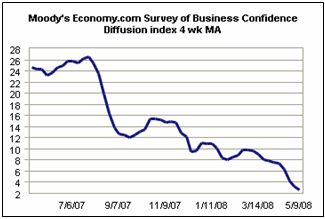
Global business confidence slipped to another new record low last week, according to Moody's Economy.com . The results of its Survey of Business Confidence suggest that the US and European economies are contracting, while the Asian and South American economies are growing below potential.
The past week witnessed a myriad US economic reports of which the following were of particular interest:
• The University of Michigan Consumer Sentiment Index dropped by 3.1 points in May. The index came in at 59.5, the lowest reading since June 1980.
• The NAHB Housing Market Index for the US as a whole decreased from 20 to 19 in May 2008, indicating that the housing market is continuing its downward slide.
• Housing starts increased by 8.2% to 1.032 million units in April. Despite the increases from a month ago, starts remain well below their year-ago levels.
• Industrial production fell by 0.7% in April, more than twice the consensus estimate. Manufacturing output fell by 0.8% – half of the decline owing to a large drop in auto production. Capacity utilization fell from 80.4% to 79.7%, its first sub-80% reading since 2005.
• Total retail sales fell by 0.2% in April, following a revised 0.2% gain in March. Sales at auto dealers tumbled. Hence, ex-auto sales rose by 0.5% after gaining 0.4% in March.
• The Consumer Price Index increased by 0.2% in April, down from 0.3% in March. Over the past year, the CPI has increased by 3.9%, although top-line inflation has slowed in recent months. The core CPI, excluding food and energy, increased by 0.1% in April, down from 0.2% in March. Over the past year, core CPI has increased by 2.3%.
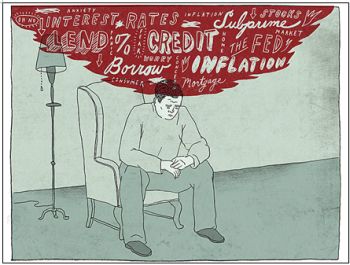
John Cassidy ( Condé Nast Portfolio.com ) reported: “Simulations carried out by Frederic Mishkin, one of Bernanke's colleagues at the Fed, imply that the typical American family will cut its spending by up to 7 cents for every dollar in housing wealth it loses. Given a 20% fall in prices, this adds up to a nationwide reduction in consumer spending of about $350 billion a year, or 2.5% of the US's gross domestic product. That's a big number – more than big enough to tip the economy into recession.”
Summarizing the economic situation, John Mauldin ( Thoughts from the Frontline ) said: “I think the Fed will be on hold for a rather long time. We are in a Muddle-through Economy. Even if the economy gets worse, the problems in the economy would not be helped by lower rates. And until the economy starts growing at a rate above 2%, it will be difficult to justify raising rates in the face of such slow growth. Given the pressure on consumer spending and housing prices, I think the recovery that should begin later this year is going to be a rather tepid one.”
Elsewhere in the world, the Bank of England reported a particularly downbeat economic outlook, while both consumer and producer prices accelerated significantly in April. Industrial production cooled in the Eurozone, but consumer inflation (3.3% year on year) remained significantly higher than the European Central Bank's 2% inflation target.
Further to the East, Japan's first-quarter GDP increased at a better-than-expected rate of 0.8% quarter on quarter, boosted strongly by exports. China ordered banks to set aside more deposits as reserves for the fourth time this year after inflation accelerated, approaching the fastest pace since 1996.
WEEK'S ECONOMIC REPORTS
| Date | Time (ET) | Statistic | For | Actual | Briefing Forecast | Market Expects | Prior |
| May 12 | 2:00 PM | Treasury Budget | Apr | $159.3B | NA | $160.0B | $177.7B |
| May 13 | 8:30 AM | Export Prices ex-ag. | Apr | 0.6% | NA | NA | 1.3% |
| May 13 | 8:30 AM | Import Prices ex-oil | Apr | 1.1% | NA | NA | 1.1% |
| May 13 | 8:30 AM | Retail Sales | Apr | -0.2% | 0.2% | -0.2% | 0.2% |
| May 13 | 8:30 AM | Retail Sales ex-auto | Apr | 0.5% | 0.7% | 0.2% | 0.4% |
| May 13 | 10:00 AM | Business Inventories | Mar | 0.1% | 0.3% | 0.4% | 0.5% |
| May 14 | 8:30 AM | Core CPI | Apr | 0.1% | 0.2% | 0.2% | 0.2% |
| May 14 | 8:30 AM | CPI | Apr | 0.2% | 0.4% | 0.3% | 0.3% |
| May 14 | 10:30 AM | Crude Inventories | 05/10 | 176K | NA | NA | 5654K |
| May 15 | 8:30 AM | Initial Claims | 05/10 | 371K | 365K | 370K | 365K |
| May 15 | 8:30 AM | NY Empire State Index | May | -3.2 | 0.0 | 0.0 | 0.6 |
| May 15 | 9:00 AM | Net Foreign Purchases | Mar | $80.4B | NA | $62.5B | $64.9B |
| May 15 | 9:15 AM | Capacity Utilization | Apr | 79.7% | 80.0% | 80.2% | 80.4% |
| May 15 | 9:15 AM | Industrial Production | Apr | -0.7% | -0.4% | -0.3% | 0.2% |
| May 15 | 10:00 AM | Philadelphia Fed | May | -15.6 | -20.0 | -19.0 | -24.9 |
| May 16 | 8:30 AM | Housing starts | Apr | 1032K | 940K | 940K | 954K |
| May 16 | 10:00 AM | Univ of Mich Consumer Sentiment | May | 59.5 | 65.0 | 62.0 | 62.6 |
Source: Yahoo Finance , May 16, 2008.
In addition to the minutes of the FOMC meeting of April 29 and 30 getting released on Thursday, the next week's economic highlights, courtesy of Northern Trust, include the following:
1. Leading Indicators (May 19): Interest rate spread, vendor deliveries, initial jobless claims, building permits, and stock prices advanced in April. Consumer expectations and the manufacturing workweek are expected to make negative contributions. Forecasts of money supply and orders of consumer durables and non-defence capital goods are used in the initial estimate. The index is likely to show a steady reading. Consensus : -0.1%.
2. Producer Price Index (May 20): The Producer Price Index for Finished Goods is expected to have risen 0.4% in April, reflecting higher food and energy prices. The core PPI is most likely to have risen by 0.2%, matching the gain seen in March. Consensus : +0.4%, core PPI +0.2%.
3. Existing Sales (May 23): Sales of existing homes are predicted to have declined to an annual rate of 4.85 million units in April from 4.93 million units in March. Consensus : 4.85 million versus 4.93 million in March.
4. Other reports : OFHEO Price Index (May 22).
Markets
The performance chart obtained from the Wall Street Journal Online shows how different global markets performed during the past week.
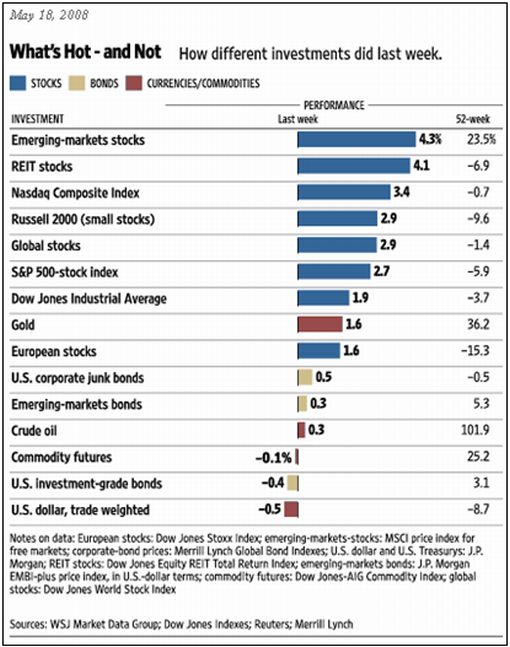
Source: Wall Street Journal Online , May 18, 2008.
Equities
Global stock markets were in rally-mode and added to the gains of the past two months, with the MSCI World Index closing 2.9% higher on Friday. The Nikkei 225 Average (+4.1%) fared the best among the mature markets. Emerging markets (+4.3%), however, showed mature markets a clean pair of heels.
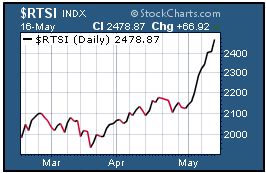
The Russian market was a highlight of the week, with the Russian Trading System Index surging by 8.5% to hit an all-time high. The Bovespa Stock Index (+4.5%), the Toronto Composite Index (+3.2%) and the South African FTSE/JSE All Share Index (+1.8%) also scaled new peaks.
The strongest US stock market index was again the Nasdaq Composite Index with a gain of 3.4% (YTD -4.7%), followed by the Russell 2000 Index with +2.9% (YTD -3.2%), the S&P 500 Index with +2.7% (YTD -2.9%) and the Dow Jones Industrial Index with +1.9% (YTD -2.1%).
From a technical point of view, a number of key indices are up against resistance levels at their 200-day moving averages, most notably the S&P 500 Index at 1,425 (closing level: 1,425) and the Dow Jones Industrial Index at 1,300 (closing level: 12,987).
Fixed-interest instruments
Fading concerns about an economic Armageddon and commensurately less safe-haven buying, together with mounting inflation worries, resulted in investors switching from government bonds to equities, pushing government bond yields higher in most parts of the world.
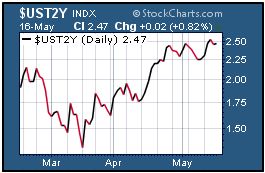
The yield on the two-year US Treasury Note closed the week 23 basis points higher at 2.46%, whereas the ten-year US Treasury Note yield increased by 9 basis points to 3.86%. Worrying inflation reports, in particular, caused the two-year UK Gilt to jump by 41 basis points (its biggest weekly rise in 14 years) to 4.80% and the ten-year UK Gilt by 19 basis points to 4.78%.
Government bonds elsewhere in the world followed a similar pattern, thereby resulting in flattening yield curves.
US mortgage rates also increased, with the 15-year fixed rate rising by 8 basis points to 5.53% and the 5-year ARM rate edging 4 basis points higher at 5.38%.
Credit market stress eased with spreads tightening considerably in both the US and Europe.
Currencies
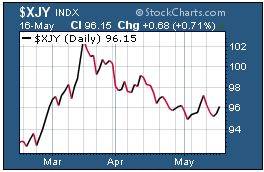
The past week again saw volatility in the currency markets, with the US dollar improving during the first half of the week, but dropping back later on poor economic data, suggesting that an interest rate increase by the Fed was unlikely any time soon.
A hawkish stance by policymakers in the Eurozone caused the US dollar to weaken by 0.4% against the euro over the week.
The Bank of England presented a gloomy economic outlook for the UK, resulting in the British pound declining to a three-month low against the US dollar by mid-week, but sterling recovered on Friday on the back of the poor US consumer confidence data.
High-yielding currencies such as the Australian dollar and New Zealand dollar strengthened markedly, as a result of a resurgence of carry trade transactions. On the other hand, low-yielding currencies such as the Japanese yen and Swiss franc came under pressure.
Commodities
On the commodity front, the Baltic Dry Index of freight costs surged to an all-time high, indicating accelerating demand for commodities such as coal, iron ore and grains.
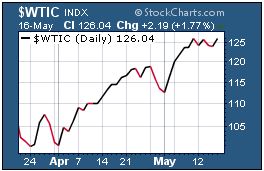
Crude oil was again in the limelight with West Texas Intermediate hitting a new peak of $127.82 a barrel on Friday before an announcement by the Saudis to boost production pulled the price down to a more modest gain of 0.3% for the week.
Goldman Sachs forecast that oil prices would average $141 a barrel during the second half of 2008.
The strong oil price and somewhat weaker US dollar positively impacted on gold (+1.6%), platinum (+1.4%) and silver (+0.3%).
Now for a few news items and some words and charts from the investment wise that will hopefully assist in steering our investment portfolios on a profitable course, and result in a pleasant backdrop to the upcoming Memorial Day holiday (May 26).

Source: Jim Sinclair's Mineset .
Bloomberg: Soros – “acute phase” of crisis is “largely behind us”
“Billionaire investor George Soros speaks at the Council on Foreign Relations in Washington about turmoil in the global financial markets and the impact of the credit crisis on the US housing market and economy. Soros said the ‘acute phase' of the financial crisis is ‘largely behind us' even as the US economy is only now starting to feel the effect.”
Source: Bloomberg , May 8, 2008.
CNBC: Roach – slow growth to spread
“World renowned bear, Stephen Roach, chairman of Morgan Stanley Asia, believes the worst is over but warns there is no light at the end of the tunnel.”
Source: CNBC , March 13, 2008.
Bloomberg: Rubenstein says “enormous” bank losses unrecognized
“US and European banks and financial institutions have ‘enormous losses' from bad loans they haven't yet recognized and may have a harder time wooing sovereign-fund rescuers, Carlyle Group Chairman David Rubenstein said.
“‘Based on information I see,' it will take at least a year before all losses are realized, and some financial institutions may fail, Rubenstein said.
“‘The sovereign wealth funds are not likely to jump into the fray again to bail out these institutions,' Rubenstein said. ‘Many financial institutions aren't going to be able to survive as independent institutions.'
“Rubenstein said sovereign wealth funds are becoming wary after losing $25 billion on their investments in struggling banks and securities firms worldwide.
“Rubenstein said today that the industry and broader economy aren't likely to turn around until early next year. ‘The truth is, we're in some kind of economic slowdown,' Rubenstein said. ‘I don't think it's going to be over for quite a while.'
“He said the US slowdown doesn't seem to be spreading to the rest of the world because the US economy makes up a smaller share of global economic activity than it has in the past, when recessions typically spread worldwide.”
Source: Ryan J. Donmoyer and Alison Fitzgerald, Bloomberg , May 12, 2008.
Bloomberg: Hatzius of Goldman – Fed funds rate is “appropriate”
“Jan Hatzius, chief US economist at Goldman Sachs Group, talks with Bloomberg's Monica Bertran about the outlook for the US housing market and economy, the impact of rising energy prices on consumer spending, and Federal Reserve monetary policy.”
Source: Bloomberg , May 16, 2008.
CNN Money: JPMorgan CEO – “recession just started”
“JPMorgan Chase & Co.'s chief executive said Monday that while the crisis in the credit markets appears to be three-quarters over, he believes a US recession is just beginning.
“‘Even if the capital markets crisis resolves, it does not mean that this country will not go into a bad recession,' said CEO James Dimon, whose bank saw its first-quarter profit fall by half due to the recent collapse of the US mortgage market. ‘The recession just started.'
“‘We don't know if it's going to be mild or severe,' he continued, speaking at a conference in New York … ‘We're thinking there's a third of a chance that it's going to be pretty bad … closer to the 1982 recession than the very mild recessions we had in 2001 and 1990.'”
Source: CNN Money , May 12, 2008.
Ambrose Evans-Pritchard (Telegraph): Avalanche of bankruptcies has begun
“Six US companies of substance have defaulted on bonds over the past fortnight, against 17 for the whole of last year.
“As a ‘non-believer' in the instant rebound story, I am not easily shocked by gloomy reports. But the latest note by Standard & Poor's – The Bust After The Boom – gave me a fright.
“As the Fed's latest loan survey makes clear, lenders have dropped the guillotine. With the usual delay, the poison is spreading from banks to the real world.
“Diane Vazza, S&P's credit chief, says defaults are rising at almost twice the rate of past downturns. ‘Companies are heading into this recession with a much more toxic mix. Their margin for error is razor-thin,' she said.
“Two-thirds have a ‘speculative' rating, compared to 50% before the dotcom bust, and 40% in the early 1990s. The culprit is debt. ‘They ramped it up in the last 18 months of the credit boom. A lot of deals were funded that should not have been funded,' she said.
“Some 174 US companies are trading at ‘distress levels'. Spreads on their bonds have rocketed above 1,000 basis points. This does not cover the carnage among smaller firms outside the rating universe.”
Source: Ambrose Evans-Pritchard, Telegraph , May 13, 2008.
Asha Bangalore (Northern Trust): Mild moderation in consumer prices
“The Consumer Price Index (CPI) rose 0.2% in April after a 0.3% increase in March. On a year-to-year basis, the CPI increased 3.94% in April, down from a recent high of a 4.31% year-to-year increase in November 2007.
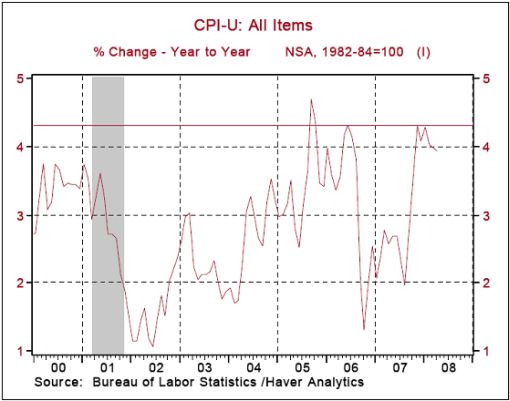
“Both weak economic conditions and inflation are at the top of the list of priorities at the Federal Reserve. The good news is that the April report showed a moderation in inflation. At the same time, inflation adjusted retail sales fell 0.3% in April, following a string of declines. … inflation adjusted retail sales have dropped for four consecutive quarters at mostly an accelerating pace.
“The weakness seen in April and forecasts of consumer spending should translate into another quarterly decline in inflation adjusted retail sales. In the inflation-growth debate at the Fed, weak demand conditions should prevail over other considerations.
“However, the Fed is not expected to make changes to the Federal funds rate in the near term. The FOMC is awaiting the lagged impact of the 325 bps reduction in the Federal funds rate and the outcome of tax rebate checks before it acts.”
Source: Asha Bangalore, Northern Trust - Daily Global Commentary , May 14, 2008.
Financial Times: Act now to avoid inflation, warns Volcker
“The Federal Reserve should forcefully tackle the risk of inflation and the weakness of the dollar now to avoid the stagflation experienced in the late 1970s, according to Paul Volcker, the former chairman of the US central bank.
“Testifying before Congress on Wednesday, Mr Volcker warned of a ‘resemblance' between the inflation outlook today and in the early 1970s, when the economy featured an overall tendency towards rising prices, as well as big increases in energy and agricultural prices.
“Mr Volcker said the response from the Fed at the time had not been ‘forceful enough' in terms of tightening monetary policy. He added: ‘If we lose confidence in the ability and the willingness of the Fed to deal with inflationary pressures and sustain confidence in the dollar, we'll be in trouble.'
“Mr Volcker served as Federal Reserve chairman between 1979 and 1987. Upon taking office, Mr Volcker moved to hike dramatically interest rates to stamp out rampant inflation but this contributed to the recession of the early 1980s.
“In his appearance before lawmakers, Mr Volcker also said that, in light of the credit crisis, the Fed's ‘lead role in banking and financial supervision should be recognised more clearly than in present law'.”
Source: James Politi and Chris Bryant, Financial Times , May 14, 2008.
Bill King (The King Report): 70's like inflation is back
“Yesterday, SF Fed President Janet Yellen said that the Fed would act to prevent 70s-style inflation. Janet, we already have ‘70s-like inflation. But now we have a CPI that is constructed to not show inflation. You cannot compare current CPI to CPI from the ‘70s. As John Williams has recently illustrated, if a pre-1983 BLS methodology is employed, CPI would be 11.6%.”
Source: Bill King, The King Report , May 14, 2008.
Financial Times: HSBC sees further pain in US housing
“The US housing market downturn could last for at least another year, HSBC predicted on Monday as it revealed it had set aside $5.8 billion because of the credit turmoil in the first quarter.
“The bank, one of the first to suffer from the meltdown in the US subprime mortgage market, said any recovery in the US housing market was unlikely this year. ‘We don't think this is a 2008 event, it's a 2009 event,' said Michael Geoghegan, chief executive.
“HSBC's position as a large lender to US customers with poor and patchy credit histories means its results are closely watched by other banks looking for any signs of an improvement in the markets. Many bankers believe securities backed by US mortgages will only stabilize once US house prices stop falling.”
Source: Peter Thal Larsen, Financial Times , May 12, 2008.
Mr Mortgage: Foreclosures escalating
“The new April California foreclosure stats are just out, compliments of Foreclosure Radar . They are now the first company with real foreclosure data on the street each month. In April, foreclosure records were set across the board in California still confirming, in my opinion, a disaster of epic proportions coming. The data continue to worsen.
“First, Notice of Defaults (NOD = pre-foreclosures) were up 2.6% to a record high of 44,100 from 42,700 last month …
“Second, Notice of Trustee Sales (NTS = Foreclosure Notices) were up 7.8% to a record high of 28,892 …
“Third, Foreclosure Sales at Auction jumped 44% for a total of approx $9.5 billion from $6.87 billion last month. This DOES NOT mean consumers bought the homes …
“Fourth, Discounts were at a record pace…
“Fifth, 97.75% of the homes failed to sell at auction so the banks bought the rest back.”
Source: Mr Mortgage , May 13, 2008.
Asha Bangalore (Northern Trust): Housing starts – details more revealing than headlines
“Construction of new homes increased 8.2% to an annual rate of 1.032 million units in April after a sharp 13.8% drop in March. The headline for April housing starts is encouraging but it disguises the details to a certain extent about the distribution of activity between single-family and multi-family construction activity. The entire strength came from the 36% jump in starts of multi-family units. Construction of these units is largely volatile and should be viewed with care. Starts of new single-family units fell 1.7% to an annual rate 692,000 in April. Breaking ground for new homes has declined in every month since May 2007.
“On a year-to-year basis, single-family starts fell 42.8%, the largest drop since November 1981. This decline is now larger than the magnitude of the drop that occurred in the 1990 recession.”
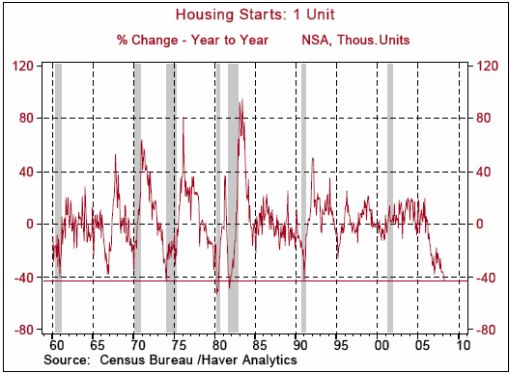
Source: Asha Bangalore, Northern Trust - Daily Global Commentary , May 16, 2008.
BCA Research: US consumer outlook – slowdown continues
“US retail sales were soft in April and persistent headwinds underscore that the consumer retrenchment is not over.
“US annual retail sales growth continues to decelerate, albeit the headline contraction of 0.2% m/m was worse than the report details. March sales were revised higher, and excluding autos and gasoline, retail sales were up 0.6% on the month. Building supplies, electronics and appliance stores were strong in April, but we doubt this trend will be sustained, given the ongoing squeeze on discretionary spending thanks to the surge in energy and food costs and housing deflation.
“Still, the main factor that will determine consumer spending behaviour will be employment growth. To this end, the NFIB small business sector survey reported a slight improvement in hiring conditions for April. Economic risks are nevertheless high and we doubt there will be much improvement in the next few quarters because the major headwinds (housing and the banking system) are still in place.”
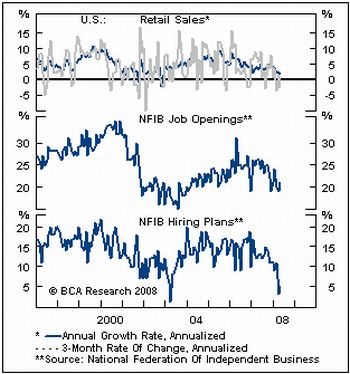
Source: BCA Research , May 14, 2008.
Asha Bangalore (Northern Trust): Consumer Sentiment Index posts a new low for current cycle
“The preliminary University of Michigan Consumer Sentiment Index declined to 59.5 in May (the lowest since June 1980) from 62.6 in April. The continued pessimism of consumers should not be surprising, given the grim news about the economy.”
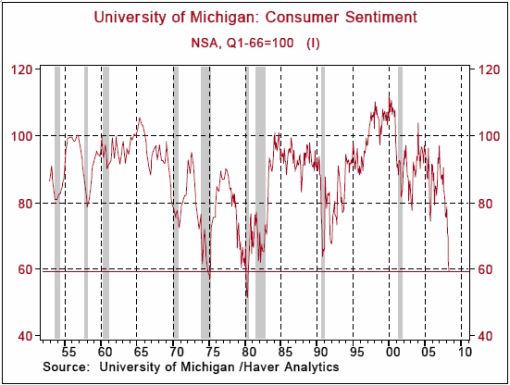
Source: Asha Bangalore, Northern Trust - Daily Global Commentary , May 16, 2008.
Asha Bangalore (Northern Trust): Factory sector's weakness – more than autos
“Industrial production fell 0.7% in April, after a revised 0.2% gain in March (previously reported as a 0.3% increase) and a 0.7% decline in February. Industrial production is of the one of the four variables the National Bureau of Economic Research uses to date business cycles. This index has peaked in January 2008. The hefty declines in February and April are part of the fundamentally weak economic profile of the US economy at present.
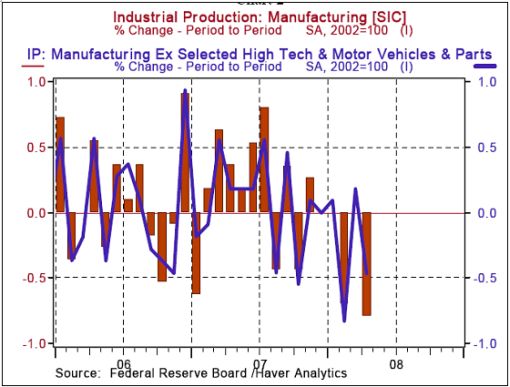
“The overall tone of the April report suggested that production in the factory sector has shifted to a noticeably lower gear of operation.”
Source: Asha Bangalore, Northern Trust - Daily Global Commentary , May 15, 2008.
CNN Money: Time to bail on bonds
“Long-term bond yields are edging close to 4%, a level they haven't touched since the end of last year. And some experts believe yields will only head higher in the coming months.
“Bonds have sold off in the past few days, pushing yields on the benchmark 10-Year US Treasury note higher, to about 3.9%. Bond yields and prices move in opposite directions.
“The rise in bond yields is significant for several reasons.
“For one, it's yet another sign that Wall Street is now worrying more about surging commodity prices and a weak dollar than a recession, weakness in housing and the credit crunch. Long-term yields tend to fall during economic slowdowns.
“‘One of the things driving yields higher is the fear of inflation. We have a weak dollar and you see that with gas and food prices,' said Brian Battle, vice president with Performance Trust Capital Partners, a Chicago-based investment firm.
“In addition, since mortgage rates and the rates for other longer-term loans tend to move in tandem with the 10-Year, a continued rise in Treasury yields should lead to higher mortgage rates.
“So how much higher will bond yields go in the near-term? Battle said that he doesn't think a 4.5% yield on the 10-Year is out of the question.
“‘Supply fears are an issue. We may have bigger deficits because of economic weakness. With lower tax revenue, more bonds being issued and higher inflation, yields will have to go higher to attract buyers,' he said.
“What's this all mean for the markets and economy? If rates keep heading higher, the Fed may finally get the hint from the bond market that it needs to worry more about inflation and less about recession.”
Source: Paul La Monica, CNN Money , May 15, 2008.
Richard Russell (Dow Theory Letters): Inflation – “coming on like gang-busters”
“The era of low interest rates may be coming to a close. Blame it on inflation, which is coming on like gang-busters. Below you see the yield on the bellwether 10-year T-note. Do I see a head-and-shoulders bottom here? I think I do. The horizontal blue line at the top of the chart comes in at about a 3.90% yield. I think the yield is going to break above that resistance line very shortly. Holding cash is becoming more interesting. Pretty soon we're going to be paid for owning cash.”
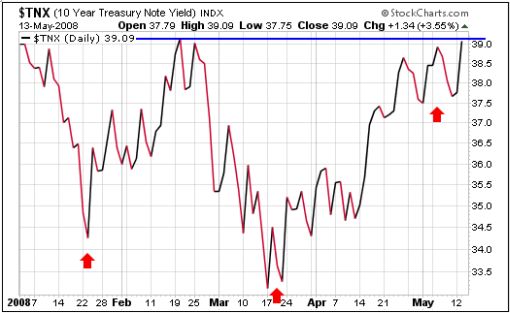
Source: Richard Russell, Dow Theory Letters , May 14, 2008.
Money News: Bill Gross – stock market euphoria premature
“Bond fund guru Bill Gross, founder of Pimco, is worried that the recent rally in equity and credit markets is premature. The continuing catastrophe in the housing market may drag down Wall Street once again, he warns.
“In a research note, Gross said the short-term stock market recovery is primarily due to federal policy moves to restore liquidity. Investors, too, seem to have bet on an overly optimistic view that the market has hit bottom and that banks are recapitalizing.
“It won't last long, Gross warns. ‘Recession, and its vicious-cycle effect on employment and consumer spending, remains a threat,' Gross says.
“In fact, real economy downturns often follow financial market corrections, since stocks lead the economy by as much as a half year. As a result, it's too early to write off the slowdown, Gross says.
“‘This recession, though currently mild, and, as of yet, not even officially validated, may not be your garden-variety, father's-Oldsmobile type of downturn.'
“Home prices, for instance, fell by nearly 13% nationwide, according to the most recent S&P/Case Shiller index. Its founder, Yale Professor Robert Shiller, sees as much as a 30% total decline before things turn around.
“The impact of such continuing asset devaluations on the economy would be ‘disastrous', said Gross.”
Source: Money News , May 5, 2008.
John Authers (Financial Times): What is message of US corporate earnings?
“What is Corporate America trying to tell us? In spite of a strangely positive reception from the markets, the first-quarter earnings season was bad both in absolute terms and relative to expectations. The latest running total from Thomson Reuters suggests that S&P 500 companies' profits are on course to fall 17.4% compared with a year ago. As the quarter began, analysts had convinced themselves that profits would rise by more than 5%.
“This is mostly down to the horrors for financials' earnings. But the energy sector has enjoyed bumper profits, thanks to similarly exceptional circumstances. Strip both sectors out and earnings growth for what remains has been an anaemic 2.8%. More companies have disappointed analysts than usual.
“The best guidance for the future may come from the earnings calls conducted by company executives. These have been handily collated by Goldman Sachs' David Kostin into what he calls a Beige Book. The good news is that ‘decoupling' holds good. Many were outspokenly positive about Latin America and China. At home, the strain for the US consumer most affected luxury goods retailers. This is still a ‘slowdown' rather than a ‘recession'.
“These messengers may not be wholly reliable, of course. But if we believe them, then it seems the credit squeeze has not yet had an effect beyond American shores, and has not yet forced the US consumer into a recession. Commodity price rises have been serious but manageable. The question is though how long can that last?”
Source: John Authers, Financial Times , May 13, 2008.
Bill King (The King Report): Watch out for sucker rally
“The big sucker rally that we warned almost always follows March (1907, 1929, 1980), and sometimes April (1987) crises as well as soft Q1s in recession years (1990, 1991, 2000, 2001, 2002) is now occurring. And after such sucker rallies, an autumn debacle is a very high probability.
“For obvious reasons, permabulls, Street paper pimps and their stooges in the fin media mitigate the fact that financial firms are and must continue to raise enormous amounts of capital and overemphasize purported good news. This helps troubled entities that are in dire need of patsies. Ergo, as benign earnings as possible are crafted, and the US government crafts benign economic statistics.”
Source: Bill King, The King Report , May 15, 2008.
Bill King (The King Report): Merrill mandates 20% sell recommendations
“Merrill Lynch has mandated that its equity analysts rate at least 20% of their companies as ‘sells'. There are two important points here. 1) Merrill is trying to inoculate itself from the type of criticism and penalties that the Street received after Enron and Global Crossing from being almost exclusively bullish. It's implicit that Merrill fears a dramatic decline in stocks and the penalties that could accrue from another zealous prosecutor or a CYA Congress. 2) It is also implicit in Merrill's mandate that it does NOT trust its own analysts to issue accurate forecasts. By mandating 20% sell recommendations, Merrill is forcing its analysts to look for negatives and ‘balance' their forecasts.”
Source: Bill King, The King Report , May 15, 2008.
GaveKal: Japanese equities are cheap
“The average dividend yield on Japanese equities is now clearly higher than the JGB yield. Historically, this has often been a good entry point for Japanese stocks.
“After years of underperformance, Japanese stocks are now very cheap. On our own equity model, the Nikkei is by far the most attractive from a valuation standpoint.”
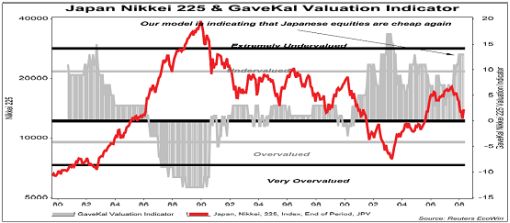
Source: GaveKal – Checking the Boxes , May 13, 2008.
Jonathan Garner (Morgan Stanley): Risk/reward for EM equities deteriorating
“It is time to take profits on emerging market (EM) equities following a 12% gain since the end of January, says Jonathan Garner, analyst at Morgan Stanley.
“He continues to believe in a core thesis of EM economic and stock market decoupling, but says the near-term risk/reward trade-off for EM equities has deteriorated.
“Firstly, Mr Garner says, the economic situation in the US and Europe continues to darken, threatening a bout of contagion in the short term. He adds that inflationary pressures within the largest EM countries are proving slower to abate than hoped, introducing more policy rate risk.
“EM equity valuations have returned close to long-term averages – and the MSCI EM stock index has recently been trading within 5% of Mr Garner's year-end target of 1,250. Furthermore, he says, earnings revisions breadth has deteriorated, suggesting downside risk to consensus earnings per share growth expectations for 2008.
“Finally, the US dollar has been strengthening slightly, providing an opportunity to take profits in key EM currencies in Asia ex-Japan and elsewhere.
“‘We are downgrading our stance on EM equities to 2% overweight from 4% overweight,' Mr Garner says.
“‘We continue to advise focusing regionally in Asia on Korea and Taiwan, in Latin America on Brazil, and in Europe on Russia. At sector level, we prefer energy, materials, telecoms and selected industrials.'”
Source: Jonathan Garner, Morgan Stanley (via Financial Times ), May 13, 2008.
Richard Russell (Dow Theory Letters): Has US dollar turned the corner?
“The daily chart below shows the dollar having rallied above its 50-day moving average and now consolidating. If the dollar rallies to 74 watch out, that would be the first upward zig-zag in a while and would signify strength. There are probably a carload of shorts in the dollar and a breakout to 74 would put the pressure on these shorts. The picture here is becoming rather interesting. Dollar strength fits it with the trend toward higher interest rates in the US. It also fits in with the idea that the euro is just too expensive on a purchasing power parity (how long can the US remain ‘candyland' for foreigners?)”
Source: Richard Russell, Dow Theory Letters , May 14, 2008.
Financial Times: Economic data take toll on British pound
“A toxic mix of data showing slowing UK economic activity and rising prices sent the pound downwards towards a three-month low against the dollar on Tuesday.
“A survey from the British Retail Consortium showed UK sales registered a 1.5% annual decline in April, the first time spending has dropped in two consecutive months since 2005.
“Meanwhile, a survey from the Royal Institute of Chartered Surveyors revealed that a record number of its members reported house price falls in the three months to April.
“The annual rate of UK CPI increased from 2.5% in March to 3% in April, way ahead of the Bank of England's 2% target and a consensus forecast for a 2.6% rise.
“The pound spiked higher as traders reasoned that surging inflation would reduce the likelihood that the Bank of England's monetary committee would cut rates by a further 25 basis points to 4.75% at its policy meeting next month.
“However, the pound's rally ran out of steam as investors reflected on the increasing evidence that the UK was facing an economic slowdown. ‘Price action in sterling indicates that the market has placed more emphasis on slowdown in growth versus higher inflation,' said Kamal Sharma of JPMorgan.”
Source: Peter Garnham, Financial Times , May 13, 2008.
David Fuller (Fullermoney): What next for commodity prices?
“The long-term [inflation-adjusted] chart below looks temporarily overextended following this year's acceleration.
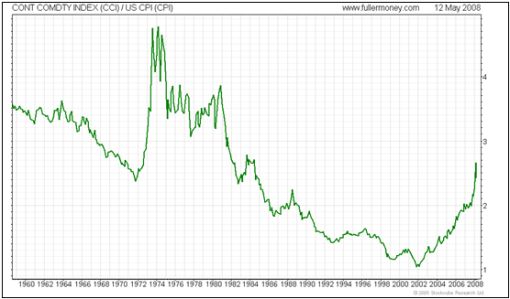
“The 5-year chart reveals a recent and considerably larger pullback, suggesting that it may have reached a medium-term peak, capping the advance for at least a few months. I would give this hypothesis the benefit of the doubt unless we see a sustained break above the end-February high.”
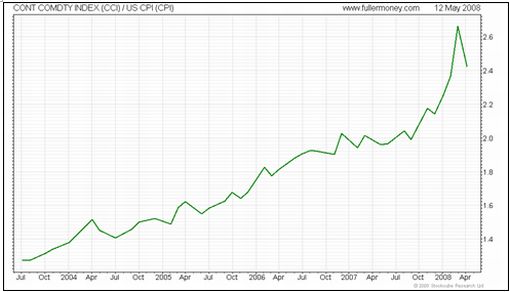
Source: David Fuller, Fullermoney , May 12, 2008.
David Fuller (Fullermoney): Commodity supercycle is alive and well
“… we most likely are on the cusp of a paradigm change regarding the price of crude oil and other industrial commodities which cannot be replenished. I maintain that the long-term price trends for these resources are upwards, albeit often very erratically, in what Fullermoney has long believed to be a commodity supercycle.
“The speed and extent of price rises and also corrections will be determined by global GDP growth, the cost of production, scarcity and substitution. These factors have always dictated commodity price trends but the numbers are now skewed much more heavily in favour of demand, with big increases coming from developing (progressing) countries with large populations.
“Coincidentally, historically low prices for many years, which arguably reached their nadir at the beginning of this decade, meant that the worldwide ability to increase the supply of resources had been compromised. Efforts to boost the production of resources in recent years have often been hampered by spiralling costs and some shortages in terms of equipment and skilled workers.
“Consequently I expect more of the same for resources prices – generally rising demand, frequent supply problems aggravated by scarcity or inaccessibility, and a rising cost of production.
“This Supply Inelasticity Meets Rising Demand situation is unlikely to change significantly without a severe global recession. Some analysts suspect this is imminent, although I maintain that is too pessimistic at this time, at least in terms of known factors. We do have an economic slowdown, aggravated by inflationary problems, but I do not envisage conditions deteriorating dramatically without an exogenous event such as a much more dramatic near-term spike in the price of crude oil towards $200.
“This price has been mentioned by Goldman Sachs and others recently, although I believe as a longer-term target. I agree and would not be surprised to see considerably higher prices over the next decade. However significant price extrapolations when trends have already steepened usually prove to be short-term contrary indicators.”
Source: David Fuller, Fullermoney , May 13, 2008.
Paul Kedrosky (Infectious Greed): T. Boone Pickens – interview on energy markets
Source: Paul Kedrosky, Infectious Greed , May 9, 2008.
Liz Ann Sonders, (Charles Schwab): Crude prices could soon retreat
“Oil prices could soon go into reverse following their steady advance over the past few months, believes Liz Ann Sonders, chief investment strategist at Charles Schwab.
“She says there has been neither a ‘supply shock' nor ‘demand shock' to drive prices higher.
“‘The pace of demand from dominant emerging regions has actually slowed, while demand from the US has declined sharply. Over the past 10 years, global oil reserves have increased by 140 billion barrels, to 1,200 billion barrels. If you add Canadian oil sands to the total, the increase was 300 billion barrels. Over that same span, the increase in world oil demand has been a benign 45 billion barrels.'
“Ms Sonders concludes that if supply and demand are not behind the recent price increases, speculation has played a key role. She points to research from ISI Group showing that over-the-counter commodity derivatives held globally grew sevenfold, to $7,000 billion, in the three years to June 2007.
“‘If we assume that only 50% of the open position is oil, the exposure as of the last data point equated to 48.5 billion barrels of oil – or about 20 times the size of the New York Mercantile Exchange market,' she says.
“‘So with the supply and demand situation not looking as bleak as expected, coupled with our contention that this speculative phase should have a limit, oil prices should abate in the near to medium term.'”
Source: Liz Ann Sonders, Charles Schwab (via Financial Times ), May 12, 2008.
Rod Smyth (RiverFront): Commodities and oil – not if, but when
“For commodities, we think the issue is when to reduce weightings, not if. This is in contrast to stocks, where we argued last week that the issue was when to add to weightings. Our challenge is to devise a methodology to assess the risk/reward in commodities. We do it by looking at the long term trend of total returns, net of inflation and observing current prices relative to the trend. This reveals that commodities in general are 25% to 30% above their 38-year inflation adjusted trend.
“Reflecting that, Riverfront recently lowered our long-term (five year plus) annual return estimate to just 3% over inflation from our estimate of over 6% per year, made last summer. With commodity prices still making new highs, momentum clearly favors retaining some exposure, but we have reduced our weightings into the current strength.
“Common sense suggests that one major commodity, oil, must soon take a breather. Oil prices surpassed $120 last week. For us, this is something of a landmark as oil prices have now risen 10 fold in ten years. The fundamental rationale for oil's strength is valid in our opinion. Indeed we have made it many times – demand is up (especially from the developing world), long-term supply is in question, geopolitical uncertainty in oil producing countries is high and the cost of extraction is rising fast.
“We think all of these positives help explain why the trend rate of oil's price advance in the last 10 years is some 20% per year, but the current price is almost 40% above that trend! Thus oil is even more extended than other commodities.”
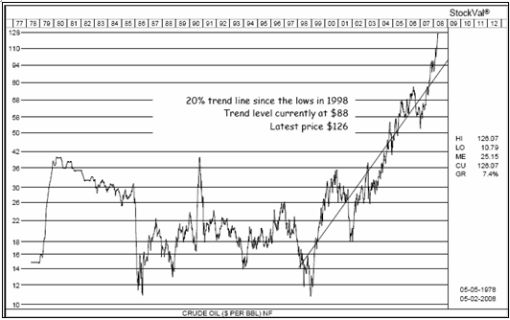
Source: Rod Smyth, RiverFront , May 12, 2008.
Ian Harnett (Absolute Strategy Research): Oil and gold
“Although high oil prices might no longer be deemed newsworthy, it is still a shock to see the ‘real' oil price – deflated by the US consumer price index – at record levels, says Ian Harnett at Absolute Strategy Research.
“‘Whenever oil prices have accelerated rapidly during the last 40 years, global growth has slowed dramatically,' says Mr Harnett. ‘The only hope is that the ‘slow-grind' that has typified the current oil price rises has allowed more time to adjust, than did the ‘shocks' that were seen in the 1970s.'
“The chief question for both the bond and equity markets is whether real oil prices normalise through the nominal oil price falling, or oil price pressures passing through into more generalised inflation. Typically, Mr Harnett says, the correction has come partly through a moderation in oil prices, but largely through headline and core consumer prices playing ‘catch-up'.
“‘Already, double-digit wage growth in many emerging markets suggests that inflation pressures are spreading.' He says an intriguing feature of the oil price spike is that it is close to a 40-year high against another dollar denominated inflation-hedge – gold.
“‘Only briefly – back in the late summer of 2005 – has an ounce of gold purchased fewer barrels of oil. We expect such a situation is unlikely to last for long … so it may be time to be long gold and short ‘black gold'.'”
Source: Ian Harnett, Absolute Strategy Research (via Financial Times ), May 15, 2008.
BCA Research: Gold – finding support?
“The gold bull market is over for now but further downside in prices should be limited.
“Gold prices took a disproportionately large hit the minute the dollar firmed a bit. Extreme dollar pessimism attracted a lot of speculators to the commodity pits in recent months, as an aggressive outlet for playing a weaker dollar. Correspondingly, there had been a lot of hot air in this market (note the huge gap that existed between the spot price and the 200-day moving average). In addition, bullion prices tend to be quite sensitive to changes (real or perceived) in the liquidity backdrop and have lost some of their support because the Fed is almost finished lowering rates and the ECB has been downplaying the odds of a rate cut.
“That said, the liquidity backdrop is not going to turn bearish (despite widespread inflation fears), nor is the dollar likely to move up much. Thus, the uptrend is on hold for the foreseeable future but gold prices should find support near the 200-day moving average (around $800).”
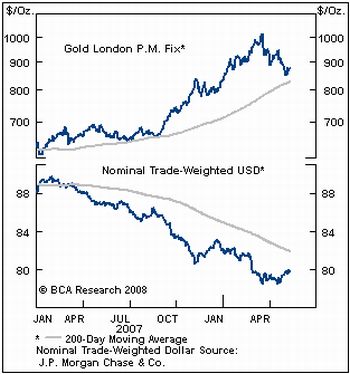
Source: BCA Research , May 12, 2008.
Richard Russell (Dow Theory Letters): Gold/silver ratio pointing the way
“Talking about the price action, I'm looking at silver, and wondering whether silver may be leading the way for gold. As subscribers know, silver's relative strength has recently been superior to gold's. Take a look at the daily chart below of the gold/silver relationship. If gold is stronger, the ratio rises. If silver is stronger, the ratio declines. The triangle you see on the chart just broke down in favor of silver.
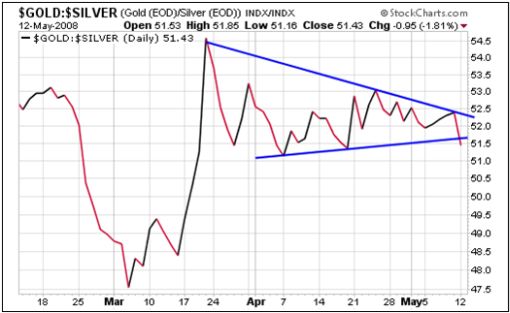
“Hopefully, silver may be leading the way for gold. Can lowly silver do that? Guess we're going to find out.”
Source: Richard Russell, Dow Theory Letters , May 13, 2008.
Financial Times: Signs of an end to soaring food prices
“The soaring food prices that have triggered global political and economic turmoil over the past year have finally shown the first tentative signs of stabilising.
“The United Nation's Food and Agriculture Organisation food price index, considered the best measure of global food inflation, saw its first decline in 15 months in April, as wheat, dairy, sugar and soyabean prices fell.
“Jose María Sumpsi, the FAO's assistant director-general, told the Financial Times earlier this week that with the exception of corn and rice, food inflation appeared to be ‘reaching its peak', although he did not expect prices to start falling.
“His comments, which are supported by other senior UN officials, and the drop in the index are the most encouraging signs since the global food crisis broke out last summer but they do not mean the problems are over.”
Source: Javier Blas, Financial Times , May 14, 2008.
Bloomberg: Trichet sees euro-area growth slowing in second quarter
Source: Bloomberg , May 15, 2008.
Ifo: Euro area – further drop in the Ifo Economic Climate indicator
“The Ifo Economic Climate in the euro area has worsened again in the second quarter of 2008 for the third time in succession, falling to its lowest level in five years. The decline in the Ifo indicator is the sole result of less positive assessments of the current economic situation. The economic expectations for the coming six months, although still in negative territory, have not worsened further.
“The economic climate has become cloudier in the second quarter of 2008 in all countries of the euro area. In Italy, France, Portugal and Spain, the current economic situation has been assessed particularly negatively, but in the majority of euro countries, the appraisals of the current economic situation remain in positive territory. In the coming six months, the slowing of economic activity will continue in all the countries of the euro area, in the opinion of the World Economic Survey (WES) experts.
“Inflation expectations, at 2.9% on average for 2008, are even more clearly above the inflation target of the European Central Bank than at the beginning of the year (2.5%). Nevertheless, in the opinion of the WES experts, key interest rates will decline somewhat in the course of the next six months; capital market rates are expected to increase slightly.
“The US dollar continues to be seen as even more strongly undervalued vis-à-vis the euro; nevertheless, in the coming six months a further, albeit only slight, weakening of the US dollar is expected. Also the Japanese yen continues to be seen as undervalued. The British pound is now regarded nearly fairly valued.”
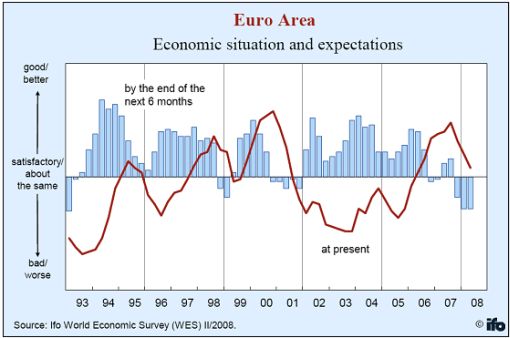
Source: Hans-Werner Sinn, Ifo , May 15, 2008.
Reuters: Europe sails into its own credit crunch
“Europe is next in line to feel the impact from tighter credit, a tough situation for an economy heavily dependent on bank financing.
“The European Central Bank's April bank lending officer survey showed a continuing sharp tightening in lending standards combined with a weakening in demand for loans.
“The survey showed that loans to businesses, consumers and house buyers all became harder to get and more expensive in the second quarter of the year. And future expectations point to further tightening.
“Why? Banks are worried about the prospects for the European economy, its housing market, their banking clients and the industries those clients compete in.
“‘If the economy is slowing down and you get a supply-driven credit squeeze on top, then you might face a more significant and more prolonged downturn in economic growth,' said Marco Annunziata, head of global economics at Unicredit in London. ‘In Europe this is a significant risk.'”
Source: James Saft, Reuters , May 14, 2008.
Bloomberg: King says further “shocks” may push UK into recession
“Bank of England Governor Mervyn King speaks at a news conference in London following the publication of the bank's quarterly inflation report. The bank said inflation will overshoot its central 2% target in two years if it cuts the benchmark rate to 4.5% in 2009 as investors predict. The Bank of England this month left the rate at 5%. Charlie Bean, BOE's chief economist, and Paul Tucker, policy maker, also speaks.”
Source: Bloomberg , May 14, 2008.
Reuters: Repossession orders surge in UK
“More people in England and Wales are just one step away from losing their homes than at any time since the early 1990s as the credit crunch bites, figures showed on Friday, and experts say things can only get worse.
“More evidence of a weakening economy adds to Prime Minister Gordon Brown's woes. Pollsters say support for his Labour Party has fallen to a record low and he now
© 2005-2022 http://www.MarketOracle.co.uk - The Market Oracle is a FREE Daily Financial Markets Analysis & Forecasting online publication.





